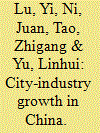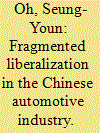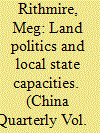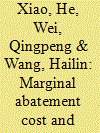|
|
|
Sort Order |
|
|
|
Items / Page
|
|
|
|
|
|
|
| Srl | Item |
| 1 |
ID:
124552


|
|
|
|
|
| Publication |
2013.
|
| Summary/Abstract |
This paper investigates the relevance of two leading theories of city-industry growth (i.e., specialization and diversity theories) in accounting for the fast yet uneven growth of industries in China's cities. Using a comprehensive dataset of manufacturing industries in 231 China's cities for the period 1998-2005, we find that specialization promotes city-industry growth, whereas diversity has no effect at all. In addition, we find that specialization is important for the growth of mature industries in China, but diversity is crucial for the development of China's relatively new and fast-growing industries. Our study contributes to the literature by examining the relevance of the specialization and diversity theories for a large and fast-growing developing economy.
|
|
|
|
|
|
|
|
|
|
|
|
|
|
|
|
| 2 |
ID:
124893


|
|
|
|
|
| Publication |
2013.
|
| Summary/Abstract |
This paper explains the extraordinary rise of the Beijing Hyundai Motor Company (BHMC), a joint venture between a state-owned enterprise run by the Beijing municipal government and Hyundai Motor Company. Within the span of three years, the BHMC soared to become China's second-ranked automotive manufacturer in terms of units sold. I highlight the role of the Beijing municipal government in creating favourable market conditions for the BHMC during its initial operation phase (2002-2005). The Beijing municipal government selectively adopted protectionist measures and liberalizing measures to promote its locally based company. I characterize this practice as fragmented liberalization, a system through which sub-national governments discriminately apply WTO or central government regulations to promote their local joint venture partner. In so doing, I also challenge the existing assumption that multinational companies are the drivers of economic liberalization, by showing Hyundai's support for local protectionism and industrial policy at the sub-national level.
|
|
|
|
|
|
|
|
|
|
|
|
|
|
|
|
| 3 |
ID:
124891


|
|
|
|
|
| Publication |
2013.
|
| Summary/Abstract |
Despite common national institutions and incentives to remake urban landscapes to anchor growth, generate land-lease revenues and display a capacious administration, Chinese urban governments exhibit varying levels of control over land. This article uses a paired comparison of Dalian and Harbin in China's north-east to link differences in local political economies to land politics. Dalian, benefiting from early access to foreign capital, consolidated its control over urban territory through the designation of a development zone, which realigned local economic interests and introduced dual pressures for enterprises to restructure and relocate. Harbin, facing capital shortages, distributed urban territory to assuage the losers of reform and promote economic growth. The findings suggest that 1) growth strategies, and the territorial politics they produce, are products of the post-Mao urban hierarchy rather than of socialist legacies, and 2), perhaps surprisingly, local governments exercise the greatest control over urban land in cities that adopted market reforms earliest.
|
|
|
|
|
|
|
|
|
|
|
|
|
|
|
|
| 4 |
ID:
132645


|
|
|
|
|
| Publication |
2014.
|
| Summary/Abstract |
China achieved an energy savings of 67.5 Mtce in the building sector at the end of the 11th Five-Year Plan and set a new target of 116 Mtce by the end of the 12th Five-Year Plan. In this paper, an improved bottom-up model is developed to assess the carbon abatement potential and marginal abatement cost (MAC) of 34 selected energy-saving technologies/measures for China×s building sector. The total reduction potential is 499.8 million t-CO2 by 2030. 4.8 Gt-CO2 potential will be achieved cumulatively to 2030. By 2030, total primary energy consumption of Chinese building sector will rise continuously to 1343 Mtce in the reference scenario and 1114 Mtce in the carbon reduction scenario. Total carbon dioxide emission will rise to 2.39 Gt-CO2 and 1.9 Gt-CO2 in two scenarios separately. The average carbon abatement cost of the aforementioned technologies is 19.5 $/t-CO2. The analysis reveals that strengthening successfully energy-saving technologies is important, especially for the residential building sector. The central government×s direct investments in such technologies should be reduced without imposing significant negative effects.
|
|
|
|
|
|
|
|
|
|
|
|
|
|
|
|
|
|
|
|
|